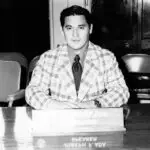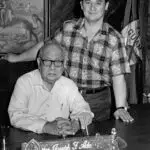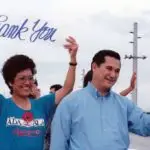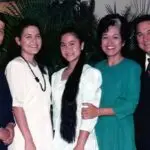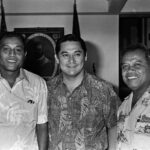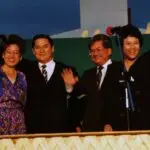Governor Joseph F. Ada
Table of Contents
Share This
Governor of Guam 1987-1994
Joseph Franklin Ada (1943 – ) served as the Governor of Guam from 1987 through 1994. Frank Blas Jr. was his lieutenant governor. Ada stewarded Guam’s economic expansion and pushed, successfully, for return of land held by the US military. He was the first governor of Guam to be re-elected to a consecutive term in office, after being re-elected in 1990.
Ada was born 3 December 1943 in Tamuning to Regina Herrero Ada and Jose Torres Ada (Familian Bodig and Ping). He graduated from John F. Kennedy High School in Tumon and then attended the College of Guam, the forerunner of the University of Guam (UOG), for two years. He went on to the University of Portland, Oregon, where he earned a Bachelor of Arts degree in Corporate Finance in 1968.
Ada came from a family of entrepreneurs – his grandfather, Josef Martinez Ada, owned Ada’s Soap Factory in Anigua from the early 1930s until his death in 1955.
Ada convinced his parents when he was about 11 years old to let him take on his first job as a bag boy at Ada’s Market. Throughout his high school and college years he made an effort to be as self-supporting as possible. He took on various jobs including that of cook, dishwasher, night manager of a small resort, lumberjack, janitor, and scrap yard worker.
Ada served as a senator and treasurer for UOG’s Student Body Association and as captain of the College of Guam’s baseball team. He was president of the International Friendship Clubs of both the College of Guam and the University of Portland. Ada attributes his lifelong sense of regionalism as something he gained by attending the University of Guam. He made friends and played baseball with fellow Micronesian island students, many who later also became leaders of their island nations.
After college he married Rosanna Santos whom he had met earlier while a student at UOG and returned to Guam. Together they had three children, Eric, Tricia and Ester, and have five grandchildren.
As a new college graduate Ada accepted the position of assistant general manager of Ada’s Incorporated, owned by his grandfather’s brother, Pedro Ada. However his passion was public service which eventually drew him into the political arena.
Ada recognized his uncle Pedro Ada and also Jesus Leon Guerrero, founder of the Bank of Guam, as two of the people who helped him succeed in his career.
Governor of Guam
With Sen. Frank F. Blas as his running mate, Ada made a bid for the Republican gubernatorial nomination in 1986 and won. Ada and Blas emerged victorious after a hard fought campaign against Democrat incumbents Gov. Ricardo J. Bordallo and Lt. Gov. Edward D. Reyes. At 42, Ada became the youngest man to date to hold the office of the Governor of Guam.
When Ada began his first term Guam was in the throes of an economic recession with the government suffering under a crushing deficit. Ada put all his administration’s efforts toward Guam’s economic recovery, and eventually he presided over one of the fastest growing and strongest economies in the island’s history due in part to a growth in tourism from a booming Japanese economy. He launched an austerity program at the start of his term and followed it with a program to encourage investment and trade from Asia. He eliminated the government deficit in three years. Despite a decrease in federal spending, Guam’s economy doubled and some 25,000 new jobs were created. A majority of these jobs were in Guam’s growing private sector. During Ada’s first term, private sector employment outstripped public sector employment in Guam’s economy for the first time in the modern era.
As chairperson of the Commission on Self-Determination, established in 1980 to lead the way toward determining a new political status for Guam, Ada presided over the completion of the Guam Commonwealth Act and presented to the people of Guam for approval in a plebiscite. Upon the Act’s approval, Ada took it to US Congress. A strong advocate for self-government and self-determination for Guam, he called for an end to Guam’s colonial status and pushed for the liberation of Guam’s economy from federal regulations. Congress, however, did not act on the Guam Commonwealth Act and Guam’s political status remains unresolved.
Ada believed that Guam needed to be financially healthy and not dependent on the US government in order to move forward politically. He said the federal government has tied Guam’s hands more than once pointing to postwar security clearance, federal land takings for US bases and the Jones Act which puts Guam at a financial disadvantage for shipping.
To address those concerns Ada said he supported the newly developed qualifying certificate program at the Guam Economic Development Authority to bring in foreign investment, pushed for good fuel rates and port lease fees to bring tuna transshipment to Guam, and worked on getting a visa waiver for visitors to Guam from Korea and Taiwan, all of which helped move Guam away from being dependent on US federal dollars. He also directed floating the first bond for infrastructure rather than ask for more federal funds.
Ada easily won re-election in 1990 and became the first governor to be elected to a consecutive term.
Second term
In his second term Ada capitalized on the fruits of his economic recovery program and made the largest investment in education in Guam up to that time. He directed the floating of a bond which made some $170 million available for the construction of a new high school in southern Guam (now Guam Southern High School), new elementary schools in Tamuning, Inalåhan and Dededo, and reconstruction of schools in Upi and Ordot-Chalan Pago. Additionally many new classrooms were built to relieve overcrowding in schools around the island. Operating budgets for the public schools were increased annually. Under Ada computers and computer classes were introduced in all Guam schools. At the end of his term every grade level in every school had access to computer classes.
Ada also directed the floating of millions of dollars in bonds to the University of Guam for construction of a new library, a new College of Agriculture and Life Sciences building, an English and Communications building, Humanities and Social Sciences building, Micronesian Area Research Center and a computer building.
Ada also obtained land from the federal government for a new Guam Community College campus, and sought additional funding to establish new training programs in the hospitality and visitor industry.
Ada negotiated a contract with US Department of Defense for the reimbursement of Guam’s cost for educating students of federal employees on Guam. The contract put millions of federal dollars into the school system. It funded new teacher recruitment and training programs and paid for supplies and renovation of facilities. Later, however, the federal government created its own Department of Defense school system on Guam due to dissatisfaction with Guam’s public schools, and this source of federal funds was lost.
Ada also oversaw the completion of one of the most ambitious road-building programs including the Hågat-Humåtak highway, reconstruction along Marine Drive and many other roads. Ada made large investments in Guam’s water and power systems which were inadequate for the island’s needs when he came into office. He floated a $60 million bond to fund new water and sewer projects, such as the Ugum River development project to put an end to annual droughts in the south, the Tumon Bay sewage reversal project and new wells, reservoirs, waterlines. He directed the construction of large, much needed emergency power generators. To meet power demands he also funded the building of two new baseload generators and backup generators for all the water wells.
The expansion of Guam Memorial Hospital and the Guam International Airport and the construction of a new skilled nursing facility and a new Department of Mental Health and Substance Abuse building also were initiated during the Ada administration. Altogether Ada directed the investment of more than half a billion dollars in infrastructure improvement throughout the government of Guam.
Housing was also important to Ada. Through the Land for the Landless Program, Ada provided thousands of house lots to qualified people who did not own their own land. He also started a program called CAHAT, to provide low-interest loans to qualified home builders or buyers.
A tourist market from Korea did not exist when Ada took office, but he saw great potential in it. He led several marketing trips to Korea and made Korea an important part of Guam’s tourism industry. Korean Air and Asiana Airlines began service to Guam during the Ada administration. Visa waivers were obtained for Korean and Taiwanese visitors to Guam. Additional flights to and from Japan were also added during his time in office, as well as the services of additional air carriers, such as ANA and United.
Guam suffered from a string of natural disasters during the second Ada administration. Four typhoons, one after another, hit Guam in 1991, with Typhoon Omar causing the most damage. On 8 August 1993 Guam was rocked by one of the most powerful earthquakes ever recorded. The temblor measured an astonishing 8.1 on the Richter Scale. Earthquake damage to Guam ran into millions of dollars though only two buildings were destroyed. These disasters, combined with a recession in Japan, caused the tourism industry to suffer for a time.
Perhaps the greatest accomplishment of the Ada administration was the closure of Naval Air Station Agana (NAS) and the turn over of the land to the government of Guam. Ada raised the idea of turning NAS over to Government of Guam (GovGuam) for airport expansion and other economic purposes at the end of his first term in office. Initially, the idea was dismissed both federally and locally. The Navy refused to discuss it, claiming that the old airbase was still vital to Naval interests. However, if GovGuam wanted to buy it from the Navy they wanted $450 million for the property. Local leaders did not think a base closure and a land transfer could ever be accomplished.
Ada pursued the idea. He enlisted support from leaders of both political parties and coined the name “Team Guam” to reflect their bipartisan approach toward closing NAS and getting back the land for the people of Guam. Team Guam convinced the Base Realignment and Closure Commission to close NAS and turn it over to the Government of Guam.
Since by law governors can only serve two consecutive terms, Ada could not seek a third term in 1994. He left office in January 1995 at the age of 51 after serving the public for more than twenty-five years. Ada is the first person ever to have held the offices of senator, legislative speaker, lieutenant governor and governor of Guam.
Ada wanted to continue to work on gaining consensus with the federal government on the issues of contention in the Guam Commonwealth Act. While he says the Act, already accepted by the people of Guam, was moving along in the federal administration, his term was up and it had not yet made its way to Congress.
He regards the Guam Commonwealth Act’s failure to be approved as the biggest disappointment of his career. Ada said he had moved the document 80 percent of the way toward its passage, including the concept of mutual consent whereby Guam and the US would have to mutually agree on policies that affected Guam, but still had 20 percent more to do, however, he simply ran out of time. Once Governor Carl TC Gutierrez took office in 1994 it stopped moving forward. Gutierrez decided to start the process over again on his own terms.
Ada believes Guam needs a new generation of fighters to resolve the island’s political status.
After a four-year break in 1998, Ada ran for Governor again with then Sen. Felix Camacho as his running mate but lost to Gutierrez and his running mate Madeleine Bordallo. Camacho ran four years later, with Sen. Kaleo Moylan as his running mate, and won to become the governor of Guam. In 2002 Ada ran for Congressional delegate against Democrat Madeleine Bordallo but lost as well.
He currently serves as the Vice-Chairman of the Board of the University of Guam Endowment Foundation. Founded by Jesus S. Leon Guerrero, the foundation is dedicated to promoting the university through academic enhancements, scholarship opportunities, and development of creative fundraising opportunities for overall improvements to the campus.
Ada family photo album
Ada family in Saipan
Ada family photo collection from Klaus Moeller
For further reading
Ada, Joseph F. “State of the Island Address.” Legislative Session Hall, Hagåtña, GU, 8 April 1987.
–––”State of the Island Address.” Legislative Session Hall, Hagåtña, GU, 11 February 1988.
––– “State of the Island Address.” Legislative Session Hall, Hagåtña, GU, 1990.

